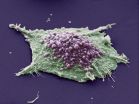(Press-News.org) Using an ambulance that included a computed tomography (CT) scanner, point-of-care laboratory, telemedicine connection and a specialized prehospital stroke team resulted in decreased time to treatment for ischemic stroke, according to a study in the April 23/30 issue of JAMA, a neurology theme issue.
Stroke is a leading cause of death and disability. In acute ischemic stroke, thrombolysis (dissolving of blood clots) using intravenous tissue plasminogen activator (tPA) is the treatment of choice after excluding bleeding in the brain by imaging. Past studies have shown time-dependent benefits of tPA, with early treatment associated with better outcomes. Apart from delayed patient presentation, management inside and outside of the hospital contributes to treatment delays. Recent data from the United States indicate that less than 30 percent of patients have a door-to-needle time for receiving tPA within the recommended 60 minutes. A recent study reported time-savings for 12 tPA administrations performed in a special ambulance with a CT scanner and laboratory. Little is known about the overall effects of specialized ambulances for treating patients with stroke, according to background information in the article.
Martin Ebinger, M.D., of Charité–Universitätsmedizin Berlin, Germany, and colleagues conducted a study in which a specialized ambulance (Stroke Emergency Mobile [(STEMO]) was randomly assigned weeks when it was available for response in Berlin, which has an established stroke care system with 14 stroke units. The ambulance was equipped with a CT scanner, point-of-care laboratory, and telemedicine connection; a tool to help identify stroke at the dispatcher level; and a specialized prehospital stroke team, which included a neurologist, paramedic, and a radiology technician. If ischemic stroke was confirmed and contraindications excluded, thrombolysis was started before transport to hospital. The overall study population included 6,182 patients.
The researchers found that compared with control weeks, the average alarm-to-treatment (defined as when the dispatcher activated the alarm to tPA administration) time reduction was 25 minutes among patients receiving tPA after STEMO deployment. Also, the rate of tPA treatment in ischemic stroke was higher after STEMO deployment (33 percent) than during control weeks (21 percent).
STEMO deployment was not associated with increased risk for intracerebral hemorrhage or 7-day mortality.
The authors note that the effects found in this study have to be weighed against costs of the STEMO concept. Depending on the configuration of the vehicle, a single STEMO ambulance costs about $1.4 million. Cost-effectiveness analyses are currently under way.
"Our study showed that the ambulance-based thrombolysis was safe, reduced alarm-to-treatment time, and increased thrombolysis rates," the researchers write. "Further studies are needed to assess the effects on clinical outcomes."
INFORMATION:
(doi:10.1001/jama.2014.2850; Available pre-embargo to the media at http://media.jamanetwork.com)
Editor's Note: This study was funded by Zukunftsfonds Berlin with co-financing by the European Regional Development Fund. Please see the article for additional information, including other authors, author contributions and affiliations, financial disclosures, etc.
Specialized ambulance improves treatment time for stroke
2014-04-22
ELSE PRESS RELEASES FROM THIS DATE:
Study examines effectiveness of medications for treating epileptic seizures in children
2014-04-22
Although some studies have suggested that the drug lorazepam may be more effective or safer than the drug diazepam in treating a type of epileptic seizures among children, a randomized trial finds that lorazepam is not better at stopping seizures compared to diazepam, according to a study in the April 23/30 issue of JAMA, a neurology theme issue.
Status epilepticus is a prolonged epileptic seizure or seizures that occurs approximately 10,000 times in children annually in the United States. Rapid control of status epilepticus is essential to avoid permanent injury and ...
Stroke treatment, outcomes improve at hospitals participating in UCLA-led initiative
2014-04-22
Administering a clot-dissolving drug to stroke victims quickly — ideally within the first 60 minutes after they arrive at a hospital emergency room — is crucial to saving their lives, preserving their brain function and reducing disability.
Given intravenously, tPA (tissue plasminogen activator) is currently the only Food and Drug Administration–approved therapy shown to improve outcomes for patients suffering acute ischemic stroke, which affects some 800,000 Americans annually.
Now, a UCLA-led study demonstrates that hospitals participating in the "Target: ...
Newly approved brain stimulator offers hope for individuals with uncontrolled epilepsy
2014-04-22
(Chicago) – A recently FDA-approved device has been shown to reduce seizures in patients with medication-resistant epilepsy by as much as 50 percent. When coupled with an innovative electrode placement planning system developed by physicians at Rush, the device facilitated the complete elimination of seizures in nearly half of the implanted Rush patients enrolled in the decade-long clinical trials.
That's good news for a large portion of the nearly 400,000 people in the U.S. living with epilepsy whose seizures can't be controlled with medications and who are not candidates ...
Physicists consider implications of recent revelations about the universe's first light
2014-04-22
Last month, scientists announced the first hard evidence for cosmic inflation, the process by which the infant universe swelled from microscopic to cosmic size in an instant. This almost unimaginably fast expansion was first theorized more than three decades ago, yet only now has "smoking gun" proof emerged.
What is this result and what does it mean for our understanding of the universe? Late last week, two members of the discovery team discussed the finding and its implications with two of the field's preeminent thought leaders.
Walter Ogburn is a postdoctoral researcher ...
Biting vs. chewing
2014-04-22
There's a new secret to get your child to behave at the dinner table—cut up their food and they'll relax.
A new Cornell study published in Eating Behaviors, found that when 6-10 year old children ate foods they had to bite with their front teeth— such as drumsticks, whole apples, or corn on the cob— they were rowdier than when these foods had been cut. "They were twice as likely to disobey adults and twice as aggressive toward other kids," said Brian Wansink, Professor and Director of the Cornell Food and Brand Lab.
During a 4-H summer camp, 12 elementary children ...
Bioinformatics profiling identifies a new mammalian clock gene
2014-04-22
PHILADELPHIA - Over the last few decades researchers have characterized a set of clock genes that drive daily rhythms of physiology and behavior in all types of species, from flies to humans. Over 15 mammalian clock proteins have been identified, but researchers surmise there are more. A team from the Perelman School of Medicine at the University of Pennsylvania wondered if big-data approaches could find them.
To accelerate clock-gene discovery, the investigators, led by John Hogenesch, PhD, professor of Pharmacology and first author Ron Anafi, MD, PhD, an instructor ...
Clinics not bogged down by red tape can ease health cost burdens
2014-04-22
Health clinics that can provide primary care for low-income patients may ease the financial burden on both hospitals and insurance companies while improving patient health, researchers have concluded.
A study of hospital admissions suggests that health clinics that avoid costs associated with insurance administration can help hospitals save money by lowering hospital admission rates and emergency room visits, according to Mark Agee, professor of economics, Penn State Altoona.
The researchers estimated that the major hospital in the area saved $201,414 annually in lower ...
Depressed? Researchers identify new anti-depressant mechanisms, therapeutic approaches
2014-04-22
DALLAS – April 22, 2014 – Researchers at UT Southwestern Medical Center are making breakthroughs that could benefit people suffering from depression.
A team of physician-scientists at UT Southwestern has identified a major mechanism by which ghrelin (a hormone with natural anti-depressant properties) works inside the brain. Simultaneously, the researchers identified a potentially powerful new treatment for depression in the form of a neuroprotective drug known as P7C3.
The study, published online in April's issue of Molecular Psychiatry, is notable because although ...
Scientists pinpoint protein that could improve small cell lung cancer therapies
2014-04-22
Approximately 15 percent of all lung cancers are small cell lung cancers (SCLC), which grow rapidly and often develop resistance to chemotherapy. However, researchers at Virginia Commonwealth University Massey Cancer Center have revealed new insights into the mechanisms leading to this resistance that may lead to improved therapies.
Chemotherapies work primarily by mediating B-cell lymphoma 2 (Bcl-2) family proteins, which are responsible for regulating cell death. Depending on their function, this family of proteins can trigger a form of cell suicide known as apoptosis ...
Risk of pregnancy greater with newer method of female sterilization
2014-04-22
(SACRAMENTO, Calif.) — The risk of pregnancy among women using a newer method of planned sterilization called hysteroscopic sterilization is more than 10 times greater over a 10-year period than using the more commonly performed laparoscopic sterilization, a study by researchers at Yale University and UC Davis has found.
Published online today in the medical journal Contraception, the study found the higher risk of pregnancy with a newer sterilization method marketed under the brand name Essure®.
"This study provides essential information for women and their doctors ...



